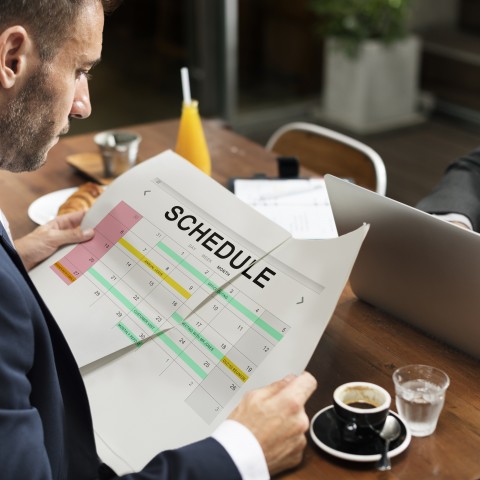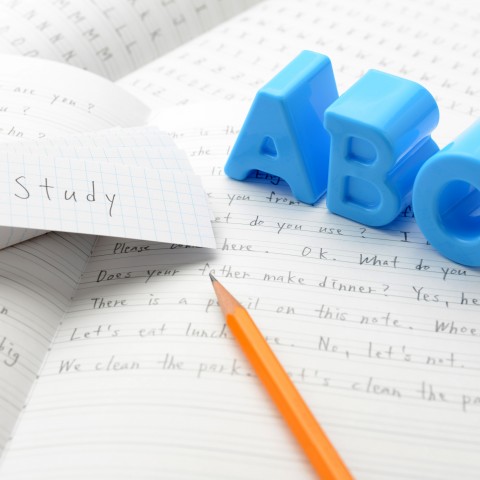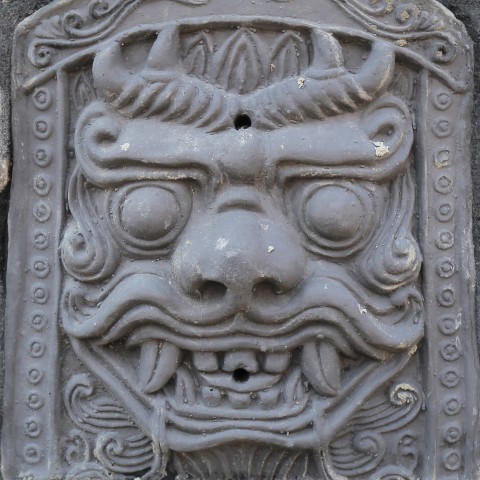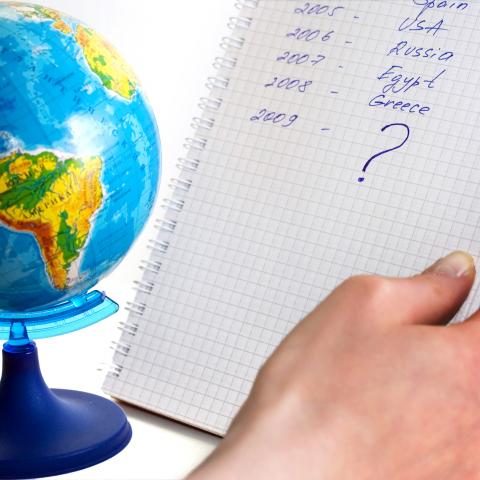
Do you plan on working in South Korea or visiting for a business trip? If so, it’s important that you learn the most common business Korean phrases.
In this article, we’ll introduce you to the most essential Korean for business, so that you’ll be prepared for any situation. By the time you finish reading, you should feel more confident in your abilities to navigate a variety of workplace or business situations, from performing well in your job interview to chatting with coworkers.
Let’s get started!
 Table of Contents
Table of Contents
- Why is it Important to Study Business Phrases?
- Nail Your Job Interview in Korean
- Business Phrases to Interact with Coworkers
- Business Phrases to Sound Smart in a Meeting
- Business Phrases to Handle Business Phone Calls & Emails
- Phrases for Your Business Trip
- Business Phrases to Greet Your Colleagues & Boss at Work
- It’s Important to Understand Business Etiquette in Korea
1. Why is it Important to Study Business Phrases?

If you’re planning to work in Korea or find a job position that requires you to speak Korean, a working knowledge of business Korean is crucial. For example, in business settings, you must use the highest politeness form to communicate with native Korean speakers; if you fail to speak business Korean, your opinions may not be heard.
By studying business Korean, you will not only be able to work effectively with Korean colleagues, but you’ll also gain their respect. Korean business is all about building relationships and respecting each other so that you can work as a team.
Are you ready to learn business Korean phrases with KoreanClass101? Then let’s go!
2. Nail Your Job Interview in Korean

Job interviews are intimidating enough in one’s native language, let alone in a foreign language! In the following sections, we’ll provide you with some practical business-level Korean for your interview.
Greetings and Introductions
Many interviewers will start by asking you to introduce yourself. As simple as it sounds, we know that self-introductions can be difficult, especially since you want to impress your interviewer.
Use the Korean phrase below to kick off your self-introduction in Korean!
| 안녕하십니까. [company’s name] [name of the position] 지원자 [name]입니다. (Annyeonghasimnikka. [company’s name] [name of the position] Jiwonja [name]imnida). “Hello. I am [name], an applicant for [company’s name] [position].” |
Always start with a greeting, because neglecting to do so will make you sound rude to the interviewer. First of all, there are two common greetings you can use:
- The Korean business greeting 안녕하십니까 (annyeonghasimnikka) is the most commonly used.
- Some people opt to use 안녕하세요 (annyeonghaseyo) to sound less serious and more friendly.
Which greeting you use is totally up to you and how you want to approach the interview. In addition, you can replace 안녕하십니까 (annyeonghasimnikka) with 처음 뵙겠습니다 (cheoeum boebgessseumnida), which means “Nice to meet you.” Better yet, you can say the two phrases together!
Examples:
안녕하십니까. 코리안클래스101 인턴 지원자 박효선입니다.
Annyeonghasimnikka. Koriankeullaeseu101 inteon jiwonja bakhyoseonimnida.
“Hello. I am Hyosun Park, an applicant for a KoreanClass101 internship.”
안녕하세요, 처음뵙겠습니다. 코리안클래스101 마케팅 지원자 매커드 미카엘입니다.
Annyeonghaseyo. Cheoeum boebgessseumnida.Koriankeullaeseu101 maketing jiwonja maekeodeu mikaelimnida.
“Hello, I am Mccard Michael, an applicant for KoreanClass101 marketing.”
Using one of these sentences is a safe way to start your self-introduction, so do memorize them. You can check out our lessons “Tell us about yourself in Korean” and “Introduce yourself in a Korean business meeting” to learn many other ways of introducing yourself in Korean.
How to Sound Smart When Asking Questions
At the end of the interview, interviewers will ask:
질문있으십니까?
Jilmunisseusimnikka?
“Do you have any questions?”
Or:
마지막으로 하고 싶은 말이나 궁금하신 점 있으십니까?
Majimageuro hago sipeun marina gunggeumhasin jeom isseusimnikka?
“Is there anything else you want to say?”
You can ask any questions, but the following business phrases in Korean tend to be favored by HR managers.
| 이 회사에서 성공하려면 제가 지원하는 직무에서 필요한 자질은 무엇입니까? I hoesaeseo seonggongharyeomyeon jega jiwonhaheun jikmueseo piryohan jajireun mueotimnikka? “What qualities do I need in my job application to be successful in this company?” 이 회사에서 직원의 자기계발을 위해 어떠한 교육을 지원합니까? I hoesaeseo jikwonui jagigyebareul wihae eotteohan gyoyugeul jiwonhamnikka? “What training does the company support for employee self-development?” |
Note that if you’re still a beginner in Korean, you should skip these phrases for now. But if you are an upper-intermediate or advanced learner, we recommend that you memorize these sentences and make the most of your chance to impress your interviewers.

3. Business Phrases to Interact with Coworkers
Building personal relationships is a crucial part of doing business in Korea. This is because Koreans believe that by turning business relationships into personal relationships, they can establish trust and build better working relationships between business partners. To facilitate this, colleagues often go out for drinks to build or maintain their relationships.
If you go drinking or have dinner with your coworkers, you’ll have a chance to get to know your colleagues a lot better. After all, you spend more than forty hours a week at work, and you never know if some of your coworkers will turn out to be your best friends.
Also, depending on the company’s culture, after-work drinking may be considered “extended” work, so it’s important to behave as such. This style is fading away slowly. We recommend adjusting your behavior according to the atmosphere of the event.
Here are some useful Korean business phrases for interacting with your coworkers!
Do you want to go drinking with us?
| 이번주 금요일 회식할 예정인데 시간돼요? Ibeonju geumyoil hoesikhal yejeonginde sigandwaeyo? “We are going to have dinner next Friday, do you want to join us? 오늘 저녁 회식하려고 해요. 같이 가지 않을래요? Oneul jeonyeok hoesikharyeogo haeyo. Gachi gaji aneullaeyo? “We are going to have dinner tonight. Would you like to come with us?” 오늘 금요일이니까 같이 한 잔 하러 갈까? Oneul geumyoirinikka gachi han jan hareo galkka? “It’s Friday, shall we go drinking?” |
Of course, you can adjust the phrases above to match your circumstances.
Examples:
폴, 다음주 월요일 회식할 예정인데 시간돼요?
Pol, daeumju woryoil hoesikhal yejeonginde sigandwaeyo?
“Paul, we are going to have dinner next Monday, do you want to join us?”
오늘 저녁 회식하려고 하는데, 같이 가지 않을래요?
Oneul jeonyeok hoesikharyeogo haeyo. Gachi gaji aneullaeyo?
“We are going to have dinner this evening, would you like to go with us?”
내일 금요일이니까 같이 한 잔 하러 갈까?
Naeil geumyoirinikka gachi han jan hareo galkka?
“Since tomorrow is going to be Friday, shall we go drinking (tomorrow)?”
Did you know that there’s a Korean gesture that means “Let’s go drink”? Check out the “Let’s Go for a Drink” section of our blog article “10 Korean Hand Gestures You Need to Know” for more details!
Yes, I would love to!
If you don’t have any plans and want to hang out with your coworkers, you can agree to go with them by saying:
| 네, 그럼요. Ne, geureomyo. “Yes, of course.” 네, 시간 괜찮아요. 같이 가요. Ne, sigan gwaenchanayo. Gachi gayo. “Yes, I’m available. Let’s go.” |
Now, let’s put it into context using the phrases we covered earlier:
폴, 다음주 월요일 회식할 예정인데 시간돼요?
Pol, daeumju woryoil hoesikhal yejeonginde sigandwaeyo?
“Paul, we are going to have dinner next Monday, do you want to join us?”
네, 시간 괜찮아요. 같이 가요.
Ne, sigan gwaenchanayo. Gachi gayo.
“Yes, I’m available. Let’s go.”
If you want to learn more Korean business phrases for accepting an invitation, check out the “Accepting an Invitation” lesson on our website.
No, I can’t go, sorry!
You don’t have to say “yes” to every drinking-out event with your coworkers. They’ll understand if you say no, so don’t feel guilty about declining their invitation. If you have other plans, you can say:
| 죄송해요, 그날 약속이 있어서 못 갈 것 같아요. Joesonghaeyo, Geunal yagsogi isseoseo mot gal geot gatayo. “I am sorry, I have some plans on that day, so I won’t be able to come.” 다음에 기회가 되면 초대해주세요. Daeume gihoega doemyeon chodaehaejuseyo. “Please invite me next time you have a chance.” 너무 가고 싶지만 못 갈 것 같아요. Neomu gago sipjiman mot gal geot gatayo. “I would love to go, but I can’t.” |
Let’s put it into context:
내일 금요일이니까 같이 한 잔 하러 갈까?
Naeil geumyoirinikka gachi han jan hareo galkka?
“Since tomorrow is going to be Friday, shall we go drinking (tomorrow)?”
죄송해요, 그날 약속이 있어서 못 갈 것 같아요.
Joesonghaeyo, Geunal yagsogi isseoseo mot gal geot gatayo.
“I am sorry, I have some plans on that day, so I won’t be able to come.”
We have study materials for “Declining an Invitation,” where we discuss this in more detail. Check it out when you have time!

4. Business Phrases to Sound Smart in a Meeting
Depending on where you plan to work, there may be required business meetings. Don’t worry! In this section, we’ll introduce you to some practical Korean for business meetings.
Shall we begin?
The business phrase below is commonly used by whoever leads the meeting. When your manager says this phrase, you can reply to him or her with 네 (ne), meaning “yes,” or simply use the silence to indirectly say that you are “ready.”
| 다들 모였으니, 시작할까요? Dadeul moyeosseuni, sijakhalkkayo? “Since everyone is here, shall we start?” |
Example:
매니저: 다들 모였으니, 시작할까요?
Maenijeo: Dadeul moyeosseuni, sijakhalkkayo?
“Since everyone is here, shall we start?”
소연: 네.
Soyeon: Ne.
Soyeon: “Yes, please.”
Let’s think of a different situation. What if you are the one who needs to lead a meeting? The phrase below is commonly used to begin a meeting, and is versatile enough to be used with your partner, a client, or even your coworkers.
| 바쁘신 와중에 시간 내주셔서 감사합니다. 그럼 시작하겠습니다. Bappeusin wajunge sigan naejusyeoseo gamsahamnida. Geureom sijakhagessseumnida. “Thank you for taking the time out of your busy schedule. Let’s get started.” |
I agree with you.
| 네, 동의합니다. Ne, donguihamnida. “Yes, I agree.” 저도 같은 생각을 가지고 있습니다. Jeodo gateun saenggageul gajigo itsseubnida. “I have the same idea.” |
Example:
다른 분들도 동의하시나요?
Dareun bundeuldo donguihasinayo?
“Do you agree with me?”
네, 동의합니다.
Ne, donguihamnida.
“Yes, I agree.”
After you’ve expressed agreement with someone’s idea, you may want to add more information or your point of view on the topic. Here’s a useful phrase for this:
| ~님의 의견에 조금 더 덧붙이자면 ~nimui uigyeone jogeum deo deotbuchijamyeon “I would like to add a little opinion to (someone)~” |
Example:
다른 분들도 동의하시나요?
Dareun bundeuldo donguihasinayo?
“Do you agree with me?”
네, 동의합니다. 추가로 대리님의 의견에 더 덧붙이자면…
Ne, donguihamnida. Chugaro daerinimui uigyeone jogeum deo deotbuchijamyeon…
“Yes, I agree. I would like to add my opinion to daerinum…”
I disagree with you.
In business, it’s normal to sometimes disagree with each other. Just remember to stay calm and communicate with each other respectfully. Here are some business phrases you can use to disagree with someone during a meeting.
| 죄송하지만 동의할 수 없는데요. Joesonghajiman donguihal su eomneundeyo. “I am sorry, but I can’t agree with you.” 음, 그렇군요. 하지만 저는 조금 다른 생각을 갖고 있습니다. Eum, geureokunyo. Hajiman jeoneun jogeum dareun saenggageul gatgo itseumnida. “Hmm, right. But I have a slightly different idea.” |
Example:
다른 분들도 동의하시나요?
Dareun bundeuldo donguihasinayo?
“Do you agree with me?”
대리님, 저는 조금 다른 생각을 갖고 있습니다.
Daerinim, jeoneun jogeum dareun saenggag-eul gatgo itsseumnida.
“I have a slightly different idea.”
아 그래요? 말씀해보세요.
A gerlaeyo? Malsseumhaeboseyo.
“Oh, is that so? Please tell me.”
Check out the “Essential Phrases for Doing Business Successfully” vocabulary list on KoreanClass101.com. There, you’ll learn twenty Korean business phrases that you can use at work right away!

5. Business Phrases to Handle Business Phone Calls & Emails
Handling business phone calls can be daunting for non-native speakers. All of the other elements you could usually apply to understand what a person is saying—such as facial expression and body language—become invisible, and you’ll have to solely rely upon the tone of their voice. However, there is always a simple manual that you can use as guidance when handling business phone calls.
When You Pick Up the Phone
Let’s say that you’re in charge of picking up phone calls. 여보세요 (yeoboseyo), a phrase that’s commonly used in daily life to say “Hello?” is rarely used in business environments.
Instead, you should use one of these two phrases when answering a phone call at work:
| 네 [company] 입니다. Ne [company] imnida. “Yes, this is [company].” 네, [company] 의 [name]입니다. Ne [company]eui [name] imnida. “Yes, this is [company]. [Name] speaking.” |
Example:
네, 코리안클래스101의 김지연입니다.
Ne, koriankeullaeseu101ui gimjiyeonimnida.
“Hello, this is KoreanClass101. Kim Jiyeon speaking.”
After you’ve used one of those phrases, the person who called will introduce themself as well.
| 안녕하세요, [company]의 [name] 입니다. [reason] 때문에 전화드렸습니다. Annyeonghaseyo, [company]ui [name] imnida. [reason] ttaemune jeonhwadeuryeotseumnida. “Hello, this is [name] of [company]. I called for [reason].” |
Let’s put it into context:
네, 코리안클래스101의 김지연입니다.
Ne, koriankeullaeseu101ui gimjiyeonimnida.
“Hello, this is KoreanClass101 Kim Jiyeon speaking”
안녕하세요, ABCD의 김철수입니다. 오늘 미팅 건때문에 전화드렸습니다.
Annyeonghaseyo, ABCDui gimcheolsuimnida. Oneul miting geonttaemune jeonhwadeuryeotseumnida.
“Hello, this is Kim Cheol-soo from ABCD. I called you for the meeting today.”
Usually, the receiver will continue the conversation with:
아, 네 안녕하세요.
A, ne annyeonghaseyo.
“Ah, yes hello.”
Or:
네 네 말씀하세요.
Ne ne malsseumhaseyo.
“Yes, yes, tell me.”
Here’s a tip for you: If you find it too difficult to understand the speaker on the phone, kindly ask them to email you instead. It’s also okay to request them to send a summary of the phone call, because in practice, it’s quite common to do this in Korea. You can say:
| 말씀하신 내용을 이메일로 받을 수 있을까요? Malsseumhasin naeyongeul imeillo badeul su isseulkkayo? “Could you send the summary (or request) from the phone call to my email?” |
When Someone is Not Available for a Phone Call
When a caller wants to speak to someone else on your team, but he or she is not available due to a meeting, you can use one of these common Korean business phrases to let the caller know that he or she is not available.
| 죄송하지만, [name] 은/는 지금 미팅중이세요. Joesonghajiman, [name] eun/neun jigeum mitingjungiseyo. “I am sorry, but [name] is in a meeting at the moment.” Or: 지금 미팅중이신데 메모라도 남겨드릴까요? Jigeum mitingjungisinde memorado namgyeodeurilkkayo? “He/she is in the meeting right now, would you like me to write a message for him/her?” 지금 미팅중이신데 전화 왔었다고 전해드릴까요? Jigeum mitingjungisinde jeonhwa wasseotdago jeonhaedeurilkkayo? “He/she is in a meeting right now, would you like me to let him/her know that you called?” |
Example:
지금 미팅중이신데 메모라도 남겨드릴까요?
Jigeum mitingjungisinde memorado namgyeodeurilkkayo?
“He/she is in a meeting right now, would you like me to write a message for him/her?”
괜찮습니다. 다시 전화하겠습니다.
Gwaenchansseumnida. Dasi jeonhwahagetseumnida.
“It’s okay. I will give him/her a call again later.”
Want to learn some more business phrases to communicate effectively on the phone in Korean? Check out our lesson “Asking for Someone on the Phone” on KoreanClass101.com!
Writing an Email
Let’s briefly cover how to write Korean business emails.
Remember, your email should start with the following sentence, or something similar:
| 안녕하세요, [name of the company] [name] 입니다. Annyeonghaseyo, [company]ui [name] imnida. “Hello, this is [name of the company] [name].” |
Example:
안녕하세요, 코리안클래스101 김지연입니다.
Annyeonghaseyo, koriankeullaeseu101ui gimjiyeonimnida.
“Hello, this is Kim Jiyeon from KoreanClass101.”
Once you have finished the body of the email, end it with:
| 감사합니다. Gamsahamnida. “Thank you.” [name] 드림 [name] deurim “From [name]” |

6. Phrases for Your Business Trip
When you’re traveling abroad for a Korean company, there’s normally someone who books hotels and flight tickets, and builds an itinerary for you and your team.
In this section, let’s focus on phrases for getting yourself checked into and out of your hotel.
Checking in at a Hotel
| 안녕하세요, [name]으로 예약 해놨는데요. Annyeonghaseyo, [name]euro yeyak haenwanneundeyo. “Hello, I made a reservation under the name of [name].” 안녕하세요, 체크인을 하고 싶습니다. Annyeonghaseyo, chekeuineul hago sipseumnida. “Hello, I would like to check in, please.” |
Checking out of a Hotel
| 체크아웃을 하고 싶습니다. Chekeuauseul hago sipseumnida. “I would like to check out, please.” |
Check out our lessons “Korean Travel Phrases” and “Going Out to Meet with a Client in South Korea” to learn more essential travel and business phrases before you head out.

7. Business Phrases to Greet Your Colleagues & Boss at Work
Now, let’s go into detail about how to greet in Korean business settings.
Generally, you can speak casually with your colleagues. However, you need to be able to adjust your level of politeness depending on the situation. For example, you can call your colleague by their name followed by unni outside the company building, or when you and your colleague are the only people in the meeting room. Just remember not to use that title during a meeting, as it will make you sound unprofessional. During a meeting, you must address your colleague with the proper title (e.g. daeri, gwajang, etc.).
How to Say Hello at Work
| 안녕하세요. Annyeonghaseyo. “Hello.” This phrase is the most commonly used greeting. 안녕하십니까. Annyeonghasimnikka. “Hello.” This business phrase is also used, but only by new employees. You can also use this when you need to introduce yourself to your team for the first time. |
Example:
[As you enter the office]
안녕하십니까.
Annyeonghasimnikka.
“Hello.”
How to Say Goodbye at Work
There are many phrases for saying goodbye to your colleagues. It’s considered rude to leave the office without greeting your colleagues, so remember to say goodbye properly.
| 내일 뵙겠습니다. Naeil boebgessseumnida. “See you tomorrow.” 먼저 가보겠습니다. Meonjeo gabogessseumnida. “I’m going to leave first.” |
먼저 가보겠습니다. (Meonjeo gabogessseumnida.) is the most commonly used phrase. It sounds natural, and people usually reply with 내일 뵈어요 (naeil boeeoyo.) or 안녕히 가세요 (annyeonghi gaseyo).
That said, don’t be disappointed if no one responds to you; usually, people are too focused on their work and just don’t hear you.
Example:
먼저 가보겠습니다.
Meonjeo gabogessseumnida.
“I’m going to leave first.”
내일 뵈어요
Naeil boeeoyo.
“See you tomorrow.”
How to Greet During Lunchtime
In Korea, lunchtime is usually around noon or one o’clock, and may last one or two hours depending on the company you work for. Here, you’ll learn a few phrases that you can say to your colleagues or boss at lunchtime, or when otherwise leaving the office.
| [If you’re leaving the office to meet a client] 다녀오겠습니다. Danyeogesseumnida. “See you later (I’ll go and come back).” [If you’re leaving the office to have lunch] 점심 먹으러 다녀오겠습니다. Jeomsim meogeureo danyeoogesseumnida. “I’m going for lunch.” [If you’re replying to someone] 점심 맛있게 드세요. Jeomsim masitge deuseyo. “Have a great lunch.” |

Learn business Korean and boost your confidence today
8. It’s Important to Understand Business Etiquette in Korea
Korea’s working style and etiquette are very different from those in Western countries. Therefore, it’s important to understand Korean etiquette at work.
Although more and more companies have deployed many methods to improve the work atmosphere—such as removing job titles for a flat organizational structure—you still need to be able to read the air and adjust your behavior accordingly. Don’t worry, because these etiquette rules can be learned very quickly. Check out the pages below to learn more about business etiquette and Korean culture at work.
- Korean Business Course – Customs, Culture, and Language
- Etiquette in South Korea
- Conducting business in Korea – Korean business culture and etiquette
By understanding these cultural differences, you’ll be able to work with Korean colleagues more effectively. Make sure to read our article on “How to Find Jobs in Korea” if you’re planning to work in South Korea one day. It explains in detail about what kind of jobs are available for foreigners and how to land your job in South Korea!
Lastly, KoreanClass101 discusses many business-related topics where we teach you business Korean phrases, talk about work etiquette, and help you explore Korean culture. We also provide free vocabulary lists, so feel free to check out our website in your spare time.
In summary, we’ve looked at key business phrases in Korean that you can start using right away. Have a question? Feel free to leave us a comment!
Good luck with your studies and have a great day!

Different Ways to Say Goodbye in Korean

There are many different ways to say goodbye in Korean, and each expression is used in a specific context. Studying Korean goodbye phrases and when to use them is crucial in developing your speaking skills, as some phrases may be considered offensive when used in the wrong context. For example, the way you say goodbye to an elder will be different from how you say goodbye to someone your own age.
In this article, you’ll learn how to say goodbye in Korean in any circumstance. By the time you’re done reading, you’ll be one step closer to conversing like a native Korean-speaker!
Are you ready? Let’s go!
 Table of Contents
Table of Contents
- The Most Common Ways to Say Goodbye
- “I gotta go. Goodbye!” & “See you again!”
- “Goodbye, see you again.”
- Saying “Thank you, goodbye,” to Strangers
- Let’s Test Your “Goodbye” Skills
- How KoreanClass101 Can Help You with Korean
1. The Most Common Ways to Say Goodbye

As you probably know already, Korean has different politeness levels of speech. So, depending on whom you’re speaking to, you need to adjust your behavior as well as the way you talk.
Let’s say that you just bought something from a supermarket. As you leave, the cashier tells you goodbye by saying: 안녕히 가세요. (Annyeonghi gaseyo.) To reply, you would need to say: 안녕히 계세요. (Annyeonghi gyeseyo.)
Did you notice the difference? The phrase is exactly the same except for the 가 (ga) and 계 (gye).
Here’s the rule for this:
When you say goodbye to someone who is leaving, or going far from where you are, you say:
— To say goodbye in Korean when you are leaving instead, you say:
|
There are many other ways to say goodbye to someone. Let’s say that you’re at the office and want to say goodbye to your manager. The business level forms of “goodbye” are:
- 안녕히 가십시오.
(Annyeonghi gasipsio.)
“Goodbye.”
- 안녕히 계십시오.
(Annyeonghi gyesipsio.)
“Goodbye.”
Now, how would you say goodbye to your friends? Here are some informal goodbye phrases:
- 잘가!
(Jalga!)
“Bye!” [Have a safe trip back home.]
- 안녕.
(Annyeong.)
“Bye.”
Be careful when using these informal phrases, and remember that they can only be used among friends. If you say this to an elder or someone of a higher status, you’ll sound extremely offensive.
Example:
- A: 가르시아 씨, 만나서 반가웠어요.
(Gareusia ssi, mannaseo bangawosseoyo.)
“It was nice meeting you, Mr. Garcia.”
- B: 저도요.
(Jeodoyo.)
“You too.”
- A: 그럼. 안녕히 가세요.
(Geureom. Annyeonghi gaseyo.)
“Goodbye.”
- B: 네. 안녕히 계세요.
(Ne. Annyeonghi gyeseyo.)
“Goodbye.”

I gotta go. See you tonight!
2. “I gotta go. Goodbye!” & “See you again!”
Let’s say that you’re at a friend’s birthday party and you realize that the last train arrives in fifteen minutes. How would you say “I gotta go” in Korean? How would you hint that you need to leave soon?
Say one of these phrases:
| Formal: 이만 들어가볼게요. (Iman deureogabolgeyo.) – “I am afraid that I need to leave now.” Formal-casual: 저 갈게요. (Jeo galgeyo.) – “I’m going.” Formal-casual: 저 가야겠어요. (Jeo gayagesseoyo.) – “I have to run.” Informal: 가야겠다. (Gayagetda.) – “I gotta go.” |
More examples:
Formal
- 죄송하지만 이만 들어가볼게요.
(Joesonghajiman iman deureogabolgeyo.)
“I’m sorry, but I need to go.”
Casual
- 앗, 벌써 시간이 이렇게 됐네. 가야겠다.
(At, beolsseo sigani ireoke dwaenne. Gayagetda.)
“Oh. Time flies. I gotta go.”

School is over! See you tomorrow!
3. “Goodbye, see you again.”
Here, you’ll learn different ways to say: “Goodbye, see you again.”
Let’s say that you and your friend are walking together and are about to go your separate ways. In this case, you can say: 또 봐! (Ttobwa!), meaning “See you!” because you’re with your friend. Another appropriate phrase would be: 안녕 (annyeong).
Now let’s say that you’re with a business partner and are about to say goodbye. The most appropriate phrase here would be: 다음에 또 뵙겠습니다. (Daeume tto boepgetseumnida.)
With the basics covered, let’s see a few more ways to give a proper farewell in Korean at different formality levels:
- 다음에 또 봐요. [formal]
(Daeume tto bwayo.)
“Catch you later.”
- 나중에 봐요! [formal-casual]
(Najunge bwayo!)
“Later!”
- 잘가요! [formal-casual]
(Jalgayo!)
“Bye bye!”
- 우리 다음에 또 봐요!
(Uri daeume tto bwayo!)
“See you again!”
- 다음에 또 봐.
(Daeume tto bwa.)
“See you again.”
- 또 봐! [casual]
(Ttoba!)
“See you!”
More examples:
- A: 오늘 정말 즐거웠어요. 고마워요.
A: Oneul jeongmal jeulgeowosseoyo. Gomawoyo.
A: “I had so much fun today. Thank you.”
- B: 별 말씀을요. 다음에 또 봬요.
B: Byeol malsseumeuryo. Daeume tto bwaeyo.
B: “Don’t mention it. I will see you next time. ”
- A: 네. 다음에 또 봬요.
A: Ne. Daeume tto bwaeyo.
A: “I will see you next time.”
Learn about parting phrases in Korea in this dedicated lesson:

Goodbye!
4. Saying “Thank you, goodbye,” to Strangers
Let’s say that you asked where the bathroom was at the department store. A receptionist kindly explained to you where the bathroom was, and you wanted to politely say: “Thank you, goodbye.” In this case, you could say: 감사합니다. 안녕히 계세요. (gamsahabnida. annyeonghi gyeseyo.) This phrase translates as: “I appreciate it. Goodbye.”
While that phrase is grammatically correct, people rarely say it in a situation like the one above.
Instead, they’re more likely to use one of these phrases:
- 네, 알겠습니다. (감사합니다.)
[Ne, algetsseumnida. (Gamsahamnida.)]
“Okay, I understand. (Thank you.)”
- 아 네, 감사합니다.
(A ne, gamsahamnida.)
“Ah okay, thank you.”
- 좋은 하루 되세요. [common phrase in the service industry]
(Joeun haru doeseyo.)
“Have a good day.”
Example:
- A: 무엇을 도와드릴까요?
A: Mueoseul dowadeurilkkayo?
A: “How may I help you?”
- B: 저..분실물 센터는 어디에 있나요?
B: Jeo..bunsilmul senteoneun eodie innayo?
B: “Um…where is the lost and found center?”
(After you receive the information)
- B: 네, 알겠습니다. 감사합니다.
B: Ne, algetsseumnida. Gamsahamnida.
B: “Okay, I understand. Thank you.”

How do you say “Have a great day” in Korean?
5. Let’s Test Your “Goodbye” Skills
Now that you’ve read all about saying goodbye in Korean, let’s do some exercises!
Q1. You’re on a date with someone and are about to say goodbye. What’s the most appropriate way to say goodbye to your date?
- 네, 알겠습니다. 감사합니다.
(Ne, algetsseumnida. Gamsahamnida.)
“Okay, I understand. Thank you.”
- 다음에 또 봬요.
(Daeume tto bwaeyo.)
“I will see you next time.”
- 안녕히 가십시오.
(Annyeonghi gasipsio.)
“Goodbye.”
Q2. You’ve finished your grocery shopping at a supermarket near your house. The cashier in front of you says 안녕히 가세요. (annyeonghi kashipshio.), meaning “Goodbye.” How would you respond?
- 무엇을 도와드릴까요?
(Mueoseul dowadeurilkkayo?)
“How may I help you?”
- 안녕히 가십시오.
(Annyeonghi gasipsio.)
“Goodbye.”
- 안녕히 계십시오.
(Annyeonghi gyesipsio.)
“Goodbye.”
Q3. You’re at a friend’s birthday party. You realize that the last bus departs soon and you need to leave the party early or you’ll miss it. How would you let your friend know that you have to go now?
- 미안, 막차버스가 12시라서… 나 가볼께.
(Mian, makchabeoseuga yeoldusiraseo..na gabolkke.)
- 미안, 막차버스가 12시라서… 안녕히 계세요.
(Mian, makchabeoseuga yeoldusiraseo… annyeonghi gyeseyo.)
- 안녕, 막차버스가 12시라서… 좋은 하루되세요.
(Annyeong, makchabeoseuga yeoldusiraseo…joeun harudoeseyo.)
Q4. Your homestay mother is about to leave the house. How would you say “goodbye” to her politely?
- 안녕히 가세요.
(Annyeonghi gaseyo.)
- 안녕.
(Annyeong.)
- 다음에 또 봬요.
(Daeume tto bwaeyo.)
Here are the answers:
Q1: 2
Q2: 3
Q3: 3
Q4: 1
If you’re still unsure about how to say goodbye in Korean, check out these two pages on KoreanClass101.com:

Hello and goodbye!
6. How KoreanClass101 Can Help You with Korean
In this article, you learned how to say goodbye in various situations. Here’s a list of pages that you can check out in your spare time to learn more about this topic with cultural insights.
- How to Say Hello and Goodbye at Your Workplace
- Learn some ways to say “goodbye” in Korean
- Etiquette in South Korea
- Korean words and phrases
Of course, you’ll need to say “Hello” before you say “Goodbye!” Here are some useful pages on the topic:
- How to Say Hello in Korean
- 한국에서 자주 쓰이는 인사말 (hangugeseo jaju sseuineun insamal) – “Common Ways to Say Hello”
- 일반적인 작별 인사법 (ilbanjeog-n jagbyeol insabeob) – “Most Common Ways to Say Goodbye”
KoreanClass101.com is the best place to learn Korean in a fast, easy, and effective way. Create your free lifetime account today for access to numerous free features, such as themed vocabulary lists and new lessons every week. We provide you with practical information related to vocabulary, grammar, and Korean culture, so you’ll never be at a loss in your Korean learning!
When was the last time you said goodbye to someone in Korean? Before you go, leave us a comment and let us know—we would love to hear your stories.
Good luck with your Korean studies!

Is Korean Hard to Learn (Or Easier Than You Think)?

So, you’ve decided to learn Korean. That’s good!
But we’re sure there’s still that creeping question at the back of your mind: Is Korean hard to learn?
In this article, we’ll answer this question and provide you with examples of things that learners find difficult (and simple) about the language. By the time you’re done reading, you may just walk away with the realization that Korean is easier than you thought!
But first…
 Table of Contents
Table of Contents
- Why Should You Learn Korean?
- Is it Hard to Learn Korean?
- What are the Hardest and Easiest Parts of Learning Korean?
- Advice for New Korean-Learners
- Why is KoreanClass101 Great for Learning Korean?
1. Why Should You Learn Korean?
Korea is becoming more and more popular worldwide, largely due to K-pop influence. Many K-pop fans learn Korean so that they can read and understand the lyrics of their favorite songs and travel to Korea one day. In fact, learning Korean will open up many new doors; you’ll be able to meet more people and understand that there are many different ways of seeing the world.
Another advantage of being able to speak Korean is that you’ll have more opportunities to be hired by a global company. This is because more and more companies are seeking bilingual or multilingual professionals every year.
Another advantage? Being bilingual is actually good for your health because it keeps your brain sharp and delays the symptoms of memory loss.
2. Is it Hard to Learn Korean?
There’s no definitive answer to this question because so many different factors come into play.
For example, many Korean words are derived from Chinese characters. Therefore, if your native language also has words derived from Chinese characters, Korean vocabulary won’t be too difficult for you. And if your native language has a similar grammatical structure (like Japanese, for example), you’ll have an easier time learning Korean than people who speak very different languages. In short, any existing similarities between your native language and Korean will help immensely!
Remember that becoming fluent in Korean requires a good deal of effort and devotion from the learner. It may be difficult at the beginning, but once you have the basics down, Korean is easy! Mastering a new language takes time, but don’t worry. Many aspects of the Korean language are simple, so you can quickly master the beginner level.
3. What are the Hardest and Easiest Parts of Learning Korean?
So what makes Korean hard to learn? And what things do most learners find easy? Let’s find out:
1 – Memorizing the Korean Alphabet = Very Easy
New Korean-learners often start by memorizing the Korean alphabet, 한글 (Hangul), which is incredibly simple and easy to learn. A lot of Korean-learners report that each Korean letter is easy to memorize and that it takes about one or two hours to memorize them all.
Each character in Korean is made of two or three elements, usually as simple as a vowel and a consonant. Each consonant and vowel has its own sound that you need to learn by heart. Once you learn the Korean alphabet, you’ll need to learn how to combine the letters/sounds to make words.
For example:
- 가 (ga) is a combination of ㄱ(g) andㅏ(a).
- 헐 (heul) is a combination of ㅎ (h),ㅓ(eo), and ㄹ (l/r).
- 모 (mo) is a combination of ㅁ (m) and ㅗ (o).
- 괘 (gwe) is a combination of ㄱ (g), ㅗ (o), andㅐ(e).
- 학교 (hakgyo) is a combination of ㅎ(h),ㅏ(a),ㄱ (g),ㄱ (g), and ㅛ (yo).
- 핸드폰 (haendeupon) is a combination of ㅎ(h),ㅐ(ae),ㄴ (n), ㄷ (d), ㅡ (eu), ㅍ (p), ㅗ (o), and ㄴ (n).
As you can see, it’s not that difficult! Once you manage to memorize all of the Korean letters and sounds, you can easily start combining different consonants and vowels to create words.
You can download our Korean Hangul eBook for free and practice Korean words in our “Learn the Korean Alphabet, Hangul, from A to Z!” lesson. Feel free to check out the page and download the Hangul charts to practice your Korean spelling, too.
2 – The Power of the Verb 하다 (hada) = Easy
Many Korean verbs are just nouns connected to the verb 하다 (hada).
For example, the verb 공부하다 (gongbuhada) is made up of the noun 공부 (gongbu) and the verb 하다 (hada). The direct translation is “study doing,” and it literally means “I study.” You can do the same thing for taking a shower: 샤워하다 (syawohada) is the combination of the word “shower,” or 샤워 (syawo), and the verb 하다 (hada).
The verb form 하다 (hada) is used in writing, and the form changes in speaking. You can say 해 (hae) or 합니다 (hamnida) instead. For example, 공부해 (gongbuhae) means “I study” and is usually spoken among friends. On the other hand, 공부합니다 (gongbuhapnida) is formal language and is appropriate to use in a formal setting (such as in business).
Examples:
- 수영 (suyeong) or “swim” (noun) + 하다 (hada) or “to do” (verb) = 수영하다 (suyeonghada) or “to swim”
- 수영합니다 (suyeonghamnida) -> a formal way to say “(I) am swimming”
- 수영해 (suyeonghae) -> a casual way to say “(I) am swimming”
Can you see how easy it is to say a simple sentence? Have a look at our article “Korean Conjunctions List: Essential Korean Conjunctions” to learn more about grammatical structures. You can also check out some other pages on KoreanClass101.com:
- Basic Korean Grammar – Recommended for beginners who want to improve their Korean writing skills
- Intermediate Drama Series
- Idioms and Phrases

3 – Learning Vocabulary Takes Time = Difficult
If the language has so many simple elements, why is Korean considered hard to learn by so many people?
Well, many Korean words are borrowed from Chinese, which means that Korean pronunciation is also similar to that of Chinese. Have a look at these vocabulary words:
Did you notice anything? 학 (hak) means “education” or “learning,” and it appears in several words that are related to education. This concept is very similar to what happens in Chinese.
Let’s have a look at a different example:
- 교사 (gyosa) – “teacher”
- 교과서 (gyogwaseo) – “textbook”
- 교육장 (gyoyukjang) – “the superintendent of education”
- 교무실 (gyomusil) – “teacher’s room”
- 교인 (gyoin) – “believer”
As you may have noticed already, 교 (gyo) means “teaching,” and it appears in words that relate to teaching. 교 (gyo) is from the Chinese characters 敎.
Many compound Korean words are derived from Chinese, so if you know Chinese characters, it will be a lot easier for you to recognize these single-syllable words. If you don’t know Chinese, it’s okay. Once you start learning Korean, you’ll begin to notice these patterns naturally.
Here are some recommended pages for you:
- Learn how to count from 1-10 in Chinese-based numbers
- Hanja – Information about how Chinese characters are used in the Korean language
- Words borrowed from Chinese – You can see the list of Korean words that were borrowed from the Chinese language.

4. Advice for New Korean-Learners
The best way to improve your Korean is to surround yourself with native speakers. That’s why people sometimes go abroad and spend many years learning their target language.
The good news is that it’s not the only way. You can learn and become fluent in a language by simply dedicating your time and effort to doing so.
There are many resources on the internet that you can use to maximize your study time. We recommend reading various websites, blogs, or magazines in Korean or watching Korean videos on Netflix or YouTube.
Also, try to make friends with native Korean-speakers. One of the best ways to make friends and learn the language is by offering a language exchange. And this way, you’ll not only learn the Korean language, but also some interesting cultural insights.
Here are a few pages you can see for more useful information:
- Best Netflix Korean Dramas to Learn Korean – Watch famous K-dramas to improve your pronunciation and listening skills.
- Secret to Mastering Korean Slang and Abbreviations – Using slang is a great way to communicate with young Koreans over the internet.
- How to Read and Write Hangul – This page is for beginners who want to master Hangul.
- Absolute Beginner Korean for Every Day – Great page to improve your Korean vocabulary skills
- Afraid to Speak Korean? 7 Ways to Improve Your Speaking Skills – Speaking a new language can be scary, so we’ve provided seven ways to improve your speaking skills!
- Hangul – This is a Wikipedia page that explains Hangul in detail.

5. Why is KoreanClass101 Great for Learning Korean?
KoreanClass101 provides many free Korean study materials for Korean-learners at every level, so please check out our website!
You’ll be able to study at your own pace, and if you want to learn Korean from a native speaker, you can also upgrade your account for access to our MyTeacher program. New lessons and vocabulary lists are posted weekly, so you’ll be able to study new words every day! There are many things that you can do on our website for free, so don’t forget to sign up for KoreanClass101 today and enjoy learning the Korean language.
Do you think that Korean is difficult to learn? Let us know your thoughts in the comments below!

The 5 Most Common Mistakes Korean Learners Make

Learning a new language isn’t easy; it takes time and effort. Many Korean learners are too afraid to start speaking Korean because they’re scared of making mistakes. But it’s important to understand that you can’t improve your Korean if you don’t keep trying. It’s okay to make mistakes—it’s how you become better at Korean!
Today, we’ll introduce the five most common mistakes Korean learners make. We’ll focus on Korean language mistakes in grammar, pronunciation, and vocabulary. In addition, we’ll give you information on how you can improve your Korean and make fewer mistakes.
 Table of Contents
Table of Contents
- Korean Pronunciation Mistakes – 합니다 (hamnida) and 같이 (gachi)
- Vocabulary Word Mistakes – 이 (i) / 가 (ga) and 은 (eun) /는 (neun)
- Homophones- 낳다 (nata) vs. 낫다 (natda) vs. 낮다 (natda)
- Korean Grammar Mistakes – Verb Stem + (는)구나 ([neun]guna)
- Other Mistakes – 생일 (saengil) vs. 생신 (saengsin)
- How KoreanClass101 Can Help You with Korean
1. Korean Pronunciation Mistakes – 합니다 (hamnida) and 같이 (gachi)
The two most common Korean mistakes regarding pronunciation are to mispronounce the words 합니다 (hamnida) and 같이 (gachi). Keep reading to learn how to avoid making these mistakes!
합니다 (hamnida)
Many Korean learners pronounce 합니다 (hamnida) as “hap-ni-da.” However, when you listen closely to native speakers, it’s pronounced “ham-ni-da.” It may sound strange to you because it sounds like 함니다 (hamnida), though this is incorrect.
Just remember that this is a special case where you need to memorize the correct pronunciation. And pronouncing it correctly will make your life a lot easier. Why? Try saying “hap-ni-da” and “ham-ni-da.” Did you notice that “hamnida” is a lot easier and faster to say?
같이 (gachi)
Now let’s look at the romanization of 같이 (gachi). Do you know what this word means? That’s right, it means “together.”
While reading each of the following words and trying to pronounce them, it will sound like “gat-ee.” However, the correct way to pronounce this word is “ga-chi.”
Let’s practice its pronunciation with these two sentences.
- 그 부분은 다뤘다고 생각합니다.
Geu bubuneun darwotdago saenggakamnida.
“I think we have covered that.”
- 다시 뵙기를 기대합니다.
Dasi boepgireul gidaehamnida.
“I look forward to seeing you again.”

2. Vocabulary Word Mistakes – 이 (i) / 가 (ga) and 은 (eun) /는 (neun)
Korean learners struggle to understand Korean particles because many of these particles do not translate directly to English. Let’s take a look at the subject markers 이 (i) and 가 (ga) and the topic markers 은 (eun) and 는 (neun).
If you want to know when you should use a subject marker versus a topic marker in a sentence, think of the topic markers (eun/neun) as meaning “as far” or “when it comes to.” This will help you construct Korean sentences.
If the sentence makes sense in your head when you plug in “as far” or “when it comes to,” then use the topic marker. If not, then use the subject marker.
Examples:
- 겨울에는 딸기가 최고지.
Gyeoureneun ttalgiga choegoji.
“When it comes to winter, strawberries are the best.”
- 저는…
jeoneun…
“as for me…”
Here are a couple of great resources on KoreanClass101.com to help you better understand how to use topic marking particles:
- Learn how to use the topic marking particles 는 (neun) and 은 (eun).
- How Do I Use the Topic Marking Particles 은 (eun) and 는 (neun)?
3. Homophones- 낳다 (nata) vs. 낫다 (natda) vs. 낮다 (natda)
Other common mistakes in Korean have to do with using the wrong word because it sounds similar to another one. These three words sound very similar, and a lot of Korean learners struggle to choose the right word. In fact, even native Korean speakers struggle to differentiate between 낳다 (nata) and 낫다 (natda). So let’s take a look at each word and learn when to use them.
낳다 (nata) vs. 낫다 (natda) vs. 낮다 (natda)
| Korean words | Romanization | Meaning |
| 낳다 | nata | “To give birth” |
| 낫다 | natda | “To recover from something” |
| 낮다 | natda | “To be low” |
Most people are able to differentiate between 낫다 (natda) and 낮다 (natda) without much of a problem. However, a lot of people—even native speakers—get confused when it comes to 낳다 (nata) and 낫다 (natda).
The best way to remember is this: When you want to say “someone gave birth,” then the 받침 (badchim) has to be the last 받침 (badchim) in the order, which is ㅎ.
Examples:
- 다리의 상처가 아직 낫지 않았어.
Dariui sangcheoga ajik natji anasseo.
“The wound on my leg is not healed yet.”
- 수잔은 어젯밤에 딸을 낳았다.
Sujaneun eojetbame ttareul naatda.
“Susan gave birth to a daughter last night.”
Practice:
Let’s say that your friend got into an accident and needs to stay in the hospital for a few days. You want to write “Get well soon ” in Korean. Which of these should you write?
- 빨리 낫길 바래. (Ppalli natgil barae.)
- 빨리 낳길 바래. (Ppalli nakil barae.)
The answer is: 빨리 낫길 바래. (Ppalli natgil barae.)
Many young Koreans make mistakes with these words, so I hope you don’t make the same mistakes!

Oops, I keep making the same mistakes again
4. Korean Grammar Mistakes – Verb Stem + (는)구나 ([neun]guna)
Let’s say that you and your friend are trying to solve mathematical questions. While marking your friend’s paper, you notice that your friend made a lot of the same mistakes over and over. How do you say “You just made a mistake again” in this situation?
When you’re certain about what you’re saying, there’s a grammatical structure that you need to learn.
Grammar rule:
| Verb Stem + (는)구나 ([neun]guna) establishes a speaker’s certainty. Rule #1: We attach 구나 (guna) to the past verb stem. Rule #2: We attach 는구나 (neunguna) to the present verb stem. |
Let’s do some exercises:
Do you know the meaning of 틀렸다 (teullyeotda)? It means “was wrong” or “made a mistake.” To say “(You) made a mistake,” you need to remove 다 (da) and attach 구나 (guna). The whole sentence becomes: 너 틀렸구나 (teulryeottguna).
Here’s another example:
걸렸다 (geollyeotda) means “to be busted.” To say “(You) are busted,” remove 다 (da) and attach 구나 (guna). The whole sentence becomes: (너) 걸렸구나! ([Neo] geollyeotguna!). This expression is commonly used among friends.
Examples:
- 이번에 네 계산은 틀렸구나!
틀렸 (teullyeot) + 구나 (guna) => 틀렸구나 (teullyeotguna)
Ibeone ne gyesaneun teullyeotguna!
“Your calculations are off this time!”
- 너 도둑질하다가 걸렸구나!
걸렸 (geollyeot) + 구나 (guna) => 걸렸구나 (geollyeotguna)
Neo dodukjilhadaga geollyeotguna!
“You got caught while you were stealing something!”
We also use it with the pattern: noun + 이구나 (iguna), as in 팀이구나! (Timiguna!) meaning “You are Tim!”
Example:
- 존이구나!
존 (Jon) + 이구나 (iguna) => 존이구나 (Joniguna)
Joniguna!
“You are John!”
There’s another very similar expression: VST + 군(요)’ (gun[yo]). It also expresses the speaker’s certainty, but we use it in formal situations.
Example:
- 그렇군요. 알겠습니다.
그렇다 (geureota) + 군요 (gunyo) => 그렇군요 (geureokunyo)
Geureokunyo. Algetseumnida.
“I see. I understand.”

Happy birthday, Grandma!
5. Other Mistakes – 생일 (saengil) vs. 생신 (saengsin)
Social rank is very important in Korean culture. As a result, it’s deeply ingrained in the Korean language.
You’ve already studied the different politeness levels of speech in Korean. In this section, we’ll focus on specific words you should use depending on social rank. Koreans use different words for people of varying social ranks, and depending on who you’re talking to, there are many words for expressing respect.
Let’s take a look at the word “birthday.” You’ve probably learned that it’s 생일 (saengil) in Korean. But did you know that there’s another word for “birthday” that you should use for people who are older than you or of a higher rank?
Let’s say that you want to say “happy birthday” to your mother. The polite form of 생일 (sangil) is 생신 (sangsin); therefore, 생신 축하드립니다. (Saengsin chukadeurimnida.) is the correct way to wish your mother a happy birthday.
Let’s take a look at different ways to wish someone a happy birthday:
- [To your friends] 축하해! (Chukahae!) – “Congratulations!”
- [To your friends] 생일 축하해! (Saengil chukahae!) – “Happy birthday!”
- [To elders] 생신 축하드립니다. (Saengsin chukadeurimnida.) – “Happy birthday!”
- [Casual-formal] 생신 축하드려요. (Saengsin chukadeuryeoyo.) – “Happy birthday!”
If you’re not familiar with the different levels of politeness in Korean, check out “Polite, Conversational Korean for Beginners.” It includes 130 free lessons that will teach you how to introduce yourself in a polite and casual way to native speakers.
KoreanClass101 also has a blog post that dives into different honorific titles. Check out “Honorific Titles: Oppa, Unni, Hyung, Nuna & More” to understand different ways you can address someone, and to gain some cultural insights.

Study at your own pace with KoreanClass101
6. How KoreanClass101 Can Help You with Korean
Being fluent in a language takes time and requires your long-term effort. Most language-learners feel embarrassed when they make mistakes, but it’s important to understand that making mistakes is part of the learning process. Also, native speakers are more than happy to correct your mistakes, so be brave!
In this article, we looked at five of the most common mistakes Korean learners make. Want to read more about how to learn Korean faster? Here are three pages that you can check out in your spare time:
- Learn how mistakes help you learn faster
- Top 5 Korean Pronunciation Mistakes to Avoid
- The Top 5 Language-Learning Mistakes Most Smart People Make
Have you recently made Korean mistakes? Share your story and what kind of Korean mistake you made. It will help us understand more about what kind of Korean mistakes people make, and it will also help other Korean learners.
Good luck with your Korean studies. Feel free to check out our website, KoreanClass101.com, for more free study materials and more!

10 Common Questions in Korean and How to Answer Them

One of the most important language skills to attain is the ability to ask and answer different questions appropriately. This is because once you understand them, you’ll be able to hold conversations with native speakers of that language.
Today, KoreanClass101 will introduce you to the ten most common questions and answers in Korean at different levels of speech. In Korea, there are many speech levels that you can utilize when conversing with people. There are three commonly used speech levels: formal (business level), formal, and informal.
 Table of Contents
Table of Contents
- What is your name?
- Where are you from?
- Do you speak Korean?
- How long have you been studying Korean?
- Have you been to Korea?
- Do you like [country’s] food?
- What are you doing?
- What’s wrong?
- How much is it?
- How is…?
- Want to Learn More Korean? We Can Help You!
1. What is your name?
This is one of the first Korean questions any beginner should learn right away. Let’s have a look at three different ways to ask “What is your name?” in Korean.
1. Formal Phrase – Business Level
| 성함이 어떻게 되세요? (Seonghami eotteoke doeseyo?) – “Could I have your name, please?” 성함이 어떻게 되십니까? (Seonghami eotteoke doesimnikka?) – “Could I have your name, please?” |
성함 (seongham) is a formal word for 이름 (ireum), which is a noun for “name.” In business, it’s offensive to ask someone’s name using the word 이름(ireum), so we use 성함 (seongham) instead to show respect to the person we’re speaking to.
Appropriate Answer – Business Level
| 제 이름은 Bob입니다. (Je ireumeun bobimnida.) – “My name is Bob.” |
제 (je) is a humble way to refer to yourself. 이름은 (ireumeun) means “name is” and 입니다 (imnida) means “it is…”
To answer with “My name is [name],” simply add your name between 이름은 (ireumeun) and 입니다 (imnida). This makes a complete sentence.
Example:
- 처음 뵙겠습니다. 성함이 어떻게 되십니까?
Cheoeum boepgetseumnida. Seonghami eotteoke doesimnikka?
“Nice to meet you. What is your name?”
- 제 이름은 윌슨입니다.
Je ireumeun wilseunimnida.
“My name is Wilson.”
2. Formal Phrase – Conversational Level
| 이름이 뭐예요? (Ireumi mwoyeyo?) – “What’s your name?” 이름이 어떻게 돼요? (Ireumi eotteoke dwaeyo?) – “What’s your name?” |
This sentence structure works exactly the same way as that of the formal phrase we just looked at.
이름 (ireum) is “name” and 뭐예요? (mwoyeyo) and 어떻게 돼요? (eotteoke dwaeyo) mean “what is…” in Korean. You can use this phrase for everyday situations, such as speaking to complete strangers (e.g. cashier, receptionist, waiter, etc.) and building a relationship with someone you’ve just met (e.g. on a date, at school, etc.).
Appropriate Answer
| 제 이름은 Bob입니다. (Je ireumeun bobimnida.) – “My name is Bob.” 제 이름은 Bob이라고 합니다. (Je ireumeun bobirago hamnida.) – “My name is Bob.” |
The answer is exactly the same as the business level one. You can even skip 제 이름 (je ireum), or “my name,” as this is very common to do in conversations.
Example:
- 이름이 뭐예요?
Ireumi mwoyeyo?
“What’s your name?”
- 제 이름은 마이클이라고 합니다.
Je ireumeun maikeurirago hamnida.
“My name is Michael.”
3. Informal Phrase – Conversational Level
| 이름이 뭐야? (Ireumi mwoya?) – “What’s your name?” 이름이 어떻게 돼? (Ireumi eotteoke dwae?) – “What’s your name?” |
You can use these phrases with various people, such as your friends and people who are the same age as you. However, it’s better to start off with a formal phrase when meeting someone for the first time, even if they’re the same age as you. It’s a way to show respect to each other. Eventually, one of you will request to talk informally, and from there, you can start talking to each other in a more casual manner.
Appropriate Answer
| Bob이야. (Bobiya.) – “I’m Bob.” |
이야 (iya) means “it is” in Korean. Add your name before this word to complete the sentence.
Example:
- 이름이 뭐야?
Ireumi mwoya?
“What’s your name?”
- 앨리스야.
Aelliseuya.
“I’m Alice.”
2. Where are you from?

This is one of the most commonly asked questions that Koreans ask foreigners, usually to start a conversation with them.
1. Formal Phrase
| 어디 출신이세요? (Eodi chulsiniseyo?) – “Where are you from?” 어느 나라에서 왔어요? (Eoneu naraeseo wasseoyo?) – “Which country did you come from?” |
어디 (eodi) and 어느 (eoneu) indicate a location. 출신 (chulsin) means “origin” and 나라 (nara) means “country.” Koreans use these phrases a lot, so try to memorize them.
Appropriate Answer
| 일본에서 왔어요. (Ilboneseo wasseoyo.) – “I am from Japan.” 일본에서 왔습니다. (Ilboneseo wassseumnida.) – “I am from Japan.” |
~에서 (~eseo) means “from~,” 왔어요 (wasseoyo) means “came,” and 왔습니다 (wassseumnida) means “come from.” Add the name of your country in Korean in front of ~에서 (~eseo) to complete the sentence.
You can find a list of countries in Korean on our website; if you don’t know how to say your country in Korean, please check it out.
Example:
- 어느 나라에서 왔어요?
Eoneu naraeseo wasseoyo?
“Which country did you come from?”
- 인도에서 왔습니다.
Indoeseo wassseumnida.
“I am from India.”
2. Informal Phrase – Conversational Level
| 어느 나라 사람이야? (Eoneu nara saramiya?) – “What is your nationality?” |
어느 나라 (Eoneu nara) means “which country” and 사람 (saram) means “person.”
Appropriate Answer
| 일본에서 왔어. (Ilboneseo wasseo.) – “I’m from Japan.” |
This sentence structure works exactly the same way as the one above: add the name of the country you want to say to the beginning of the sentence.
Example:
- 어느 나라 사람이야?
Eoneu nara saramiya?
“What is your nationality?”
- 인도네시아에서 왔어.
Indonesiaeseo wasseo.
“I’m from Indonesia.”

Do you speak Korean?
3. Do you speak Korean?
There are many Koreans who can speak English. They’ve been learning English as their second language since they were in primary school, and many of the younger generations spend years in English-speaking countries to become fluent. However, when you travel to very remote areas of South Korea, bilingual or trilingual Koreans will be a rarity. This can make it challenging for you to travel around, especially when it comes to purchasing train tickets or buying specific items. But you can always ask questions politely; it’s better than nothing!
Here are the Korean questions and answers you can use to find out what languages your interlocutor speaks, or let them know your current Korean level.
1. Formal Phrase
| 한국어 할 수 있습니까? (Hangugeo hal su itseumnikka?) – “Do you speak Korean?” |
할 수 있습니까? (Hal su itseumnikka?) means “Can you do ~?” in Korean.
“English” is spelled 영어 (yeongeo), and “Can you speak English?” is 영어 할 수 있습니까? (Yeongeo hal su issseumnikka?).
Do you want to know how to spell or say your language in Korean? Check out our list of the Top 38 Languages Spoken in the World on KoreanClass101.com.
Appropriate Answer
| 조금 할 수 있습니다. (Jogeum hal su isseumnida.) – “Yes, I speak a little.” 네, 잘 할 수 있습니다. (Ne, Jal hal su isseumnida.) – “Yes, I speak fluently.” 아뇨. 못 합니다. (Anyio. Mot hamnida.) – “No, I don’t.” |
Example: 미국에 가본 적 있어
- 불가리어 할 수 있습니까?
Bulgariaeo hal su issseumnikka?
“Can you speak Bulgarian?”
- 아니요, 못 합니다.
Aniyo, mot hamnida.
“No, I can’t.”
2. Informal Phrase – Conversational Level
Here’s an informal way to ask the same question.
| 영어 할 수 있어? (Yeongeo hal su isseo?) – “Do you speak English?” |
Appropriate Answer
| 응, 조금 할 수 있어. (Eung, jogeum hal su isseo.) – “Yes, I speak a little.” 응, 할 수 있어. (Eung, hal su isseo.) – “Yes, I speak fluently.” 아니. 못해. (Ani. Mot hae.) – “No, I don’t.” |
Example:
- 불가리어 할 수 있어?
Bulgariaeo hal su issseumnikka?
“Can you speak Bulgarian?”
- 응, 조금 할 수 있어.
Eung, jogeum hal su isseo.
“Yes, I speak a little.”

4. How long have you been studying Korean?
If you’ve been speaking Korean with your interlocutor, they may be curious how long you’ve been learning. Following are some simple Korean questions and answers you should learn and be prepared for!
1. Formal Phrase
| 한국어 공부한지 얼마나 됐어요? (Hangugeo gongbuhanji eolmana dwaesseoyo?) – “How long have you been studying Korean?” 한국어 공부한지 오래됐어요? (Hangugeo gongbuhanji oraedwaesseoyo?) – “Have you been studying Korean for a long time?” |
얼마나 됐어요? (Eolmana dwaesseoyo?) means “How long has it been since~” and 오래됐어요? (Oraedwaesseoyo?) means “Has it been long since~” in Korean.
To ask about a different language, just add the appropriate word in front of 공부한지 (gongbuhanji) to complete the sentence.
Appropriate Answer
| #년/개월/달 됐어요. (#nyeon/gaewol/dal dwaesseoyo.) – “It’s been #year/month/month.” 한국어 공부한지 얼마 되지 않았어요. (Hangugeo gongbuhanji eolma doeji anasseoyo.) – “It has not been long since I studied Korean.” 한국어 공부한지 좀 됐어요. (Hangugeo gongbuhanji jom dwaesseoyo.) – “It’s been awhile since I’ve been studying Korean.” |
There are various ways to answer this question, and it’s your time to shine. Usually, Koreans don’t appreciate it when someone brags about themselves, so find a way to answer humbly.
년 (nyeon) means “year.” 개월 (gaewol) and 달 (dal) mean “month(s).”
한국어 공부한지 얼마 되지 않았어요 (Hangugeo gongbuhanji eolma doeji anasseoyo) literally means “It has not been long since I studied Korean,” though it’s also a humble way to express that you’re fluent in Korean, but don’t want to show off your skills.
Example:
- 한국어 공부한지 얼마나 됐어요?
Hangugeo gongbuhanji eolmana dwaesseoyo?
“How long has it been since you started studying Korean?”
- 한국어 공부한지 1년 됐어요.
Hangugeo gongbuhanji ilnyeon dwaesseoyo.
“It has been a year since I started studying Korean.”
2. Informal Phrase – Conversational Level
| 한국어 공부한지 얼마나 됐어? (Hangugeo gongbuhanji eolmana dwaesseo?) – “How long have you been studying Korean?” 한국어 공부한지 오래됐어? (Hangugeo gongbuhanji oraedwaesseoyo?) – “Have you been studying Korean for a long time?” |
There’s not much difference, except that the polite form 요 (yo) is removed.
Appropriate Answer
| #년/개월/달 됐어. (#nyeon/gaewol/dal dwaesseo.) – “It’s been #year/month/month.” 한국어 공부한지 얼마 되지 않았어. (Hangugeo gongbuhanji eolma doeji anasseo.) – “It has not been long since I studied Korean.” 한국어 공부한지 좀 됐어. (Hangugeo gongbuhanji jom dwaesseoyo.) – “It’s been awhile since I’ve been studying Korean.” |
There’s not much difference, except that the polite form 요 (yo) is removed.
Example:
- 한국어 공부한지 얼마나 됐어?
Hangugeo gongbuhanji eolmana dwaesseo?
“How long have you been studying Korean?”
- 한국어 공부한지 좀 됐어. 한 4년 됐나?
Hangugeo gongbuhanji jom dwaesseoyo. Han sanyeon dwaenna?
“It’s been awhile. About four years?”

Have you been to Korea?
5. Have you been to Korea?
The person you’re speaking with may be curious about what countries you’ve been to (or maybe you’re the one who’s curious!). Below are some basic questions and answers in Korean that will be useful in a situation like this.
1. Formal Phrase
| 미국에 가본 적 있어요? (Miguge gabon jeok isseoyo?) – “Have you been to America?” 미국으로 여행한 적 있어요? (Migugeuro yeohaenghan jeok isseoyo?) – “Have you ever traveled to America?” |
Appropriate Answer
| “Yes I have” answers: 네, 가본 적 있습니다. (Ne, gabon jeok isseumnida.) – “Yes, I have been.” 네, 여행한 적 있습니다. (Ne, yeohaenghan jeok isseumnida.) – “Yes, I have traveled [there].” 네, 가본 적 있어요. (Ne, gabon jeok isseoyo.) – “Yes, I’ve been there.” 네, 여행한 적 있어요. (Ne, yeohaenghan jeok isseoyo.) – “Yes, I have traveled [there].” “No I haven’t” answers: 아니요, 가본 적 없습니다. (Aniyo, gabon jeok eopseumnida.) – “No, I have never been.” 아니요, 없습니다. (Aniyo, eopseumnida.) – Literally: “No, not.” |
Example:
- 미국에 가본 적 있어요?
Miguge gabon jeok isseoyo?
“Have you been to America?”
- 네, 가본적 있어요.
Ne, gabon jeok isseoyo.
“Yes, I have.”
2. Informal Phrase – Conversational Level
| 미국에 가본적 있어? (Miguge gabon jeok isseo?) – “Have you been to America?” 미국으로 여행한 적있어? (Migugeuro yeohaenghan jeok isseo?) – “Have you ever traveled to America?” |
As you may have already guessed, informal phrases are exactly the same as the formal ones, except that the polite form 요 (yo) is removed from each sentence.
Appropriate Answer
| “Yes I have” answers: 응, 가본적 있어. (Eung, gabon jeok isseo.) – “Yes, I’ve been there.” 응, 여행한 적 있어. (Eung, yeohaenghan jeok isseoyo.) – “Yes, I have traveled [there].” “No I haven’t” answers: 아니, 가본 적 없어. (Ani, gabon jeok eopseo.) – “No, I’ve never been.” 아니, 없어. (Ani, eopseo.) – Literally: “No, there is not.” |
응 (eung) is a casual, conversational word to say “yes” and 아니 (ani) is an informal way to say “no” in Korean.
Example:
- 미국에 가본적 있어?
Miguge gabon jeok isseo?
“Have you been to America?”
- 아니, 가본적 없어.
Ani, gabon jeok eopseo.
“No, I’ve never been.”
6. Do you like [country’s] food?
This question is a great way to start a conversation, especially when you want to go to a restaurant.
1. Formal Phrase
| 태국 음식 좋아해요? (Taeguk eumsik joahaeyo?) – “Do you like Thai food?” |
음식 (eumsik) means “food” and 좋아해요? (joahae?) means “I like~” in Korean. You can add any noun in front of 좋아해요? (joahaeyo?) to say “Do you like ~?” but let’s focus on food here.
To ask about a country’s food, you need to write the name of the country, followed by 음식 (eumsik), meaning “food.” For example, if you want to say “Italian food,” then it would be 이탈리아 음식 (itallia eumsik).
Appropriate Answer
| 네, 태국 음식 좋아해요. (Ne, taeguk eumsik joahaeyo.) – “Yes, I like Thai food.” 아니요, 태국 음식 좋아하지 않아요. (Aniyo, taeguk eumsik joahaji anayo.) – “No, I don’t like Thai food.” |
Example:
- 비빔밥 좋아해요?
Bibimbap joahaeyo?
“Do you like Bibimbap?”
- 네, 좋아해요.
Ne, joahaeyo.
“Yes, I like it.”
2. Informal Phrase – Conversational Level
| 태국 음식 좋아해? (Taeguk eumsik joahae?) – “Do you like Thai food?” |
Appropriate Answer
| 응, 태국 음식 좋아해. (Eung, taeguk eumsik joahaeyo.) – “Yes, I like Thai food.” 아니, 태국 음식 좋아하지 않아. (Ani, taeguk eumsik joahaji ana.) – “No, I don’t like Thai food.” |
Example:
- 태국 음식 좋아해?
Taeguk eumsik joahae?
“Do you like Thai food?”
- 아니, 태국 음식 좋아하지 않아.
Ani, taeguk eumsik joahaji ana.
“No, I don’t like Thai food.”

What on earth are you doing?
7. What are you doing?
This is a useful question to know in any language. Here are a few ways you can ask and answer this question.
1. Formal Phrase
| 지금 뭐하세요? (Jigeum mwohaseyo?) – “What are you doing?” 뭐하고 계세요? (Mwohago gyeseyo?) – “What are you doing?” |
지금 (jigeum) means “now,” and 지금 뭐하세요? (Jigeum mwohaseyo?) literally means “What are you doing right now?”
Do be careful of your tone when you say this, because it may also sound like “What on earth are you doing?!” in Korean. If you’re a big fan of Korean dramas, you’ve probably heard this phrase a lot. If you want to avoid ambiguity, stick to 뭐하고 계세요? (Mwohago gyeseyo?), or “What are you doing?” which sounds friendlier than the previous phrase.
Appropriate Answer
| 지금 일하고 있어요. (Jigeum ilhago isseoyo.) – “I’m working now.” 전화 하고 있어요. (Jeonhwa hago isseoyo.) – “I’m on the phone.” |
There are two simple ways to answer:
- 지금 [noun]하고 있어요. (Jigeum ~ isseoyo.) – “I’m ~ing now.”
- [noun] 하고 있어요. ([noun]~ hago isseoyo.) – “I’m ~ing.”
To complete the sentence, all you need to do is add a noun to the middle of the sentence and at the beginning of the sentence, respectively. For example, if you want to say “I am swimming now,” “swim” is 수영 (suyeong) in Korean. So the full sentence becomes: 지금 수영하고 있어요. (Jigeum suyeonghago isseoyo.)
Example:
- 뭐하고 계세요?
Mwohago gyeseyo?
“What are you doing?”
- 지금 청소하고 있어요. 무슨 일 있어요?
Jigeum cheongsohago isseoyo. Museun il isseoyo?
“I’m cleaning now. What’s going on?”
2. Informal Phrase – Conversational Level
| 지금 뭐해? (Jigeum mwohae?) – “What are you doing right now?” 뭐하고 있어? (Mwohago isseo?) – “What are you doing?” |
If you want to ask this question even more casually, you can say 뭐해 (mwohae), or “What are you doing?”
Appropriate Answer
| 지금 [noun]하고 있어. (Jigeum [noun]~hago isseo.) – “I’m ~ing now.” [noun]하고 있어. ([noun]~hago isseo.) – “I’m ~ing.” |
The rules for constructing each sentence above are exactly the same as for the formal answers.
Example:
- 뭐하고 있어?
Mwohago isseo?
“What are you doing?”
- 공부하고 있어. 무슨일 있어?
Gongbuhago isseo. Museun il isseo?
“I was studying. What’s up?”
8. What’s wrong?
This is such an important question to know, because you never know when your Korean friend will be sick or feeling down. Here are some ways to ask this question, and answer it.
1. Formal Phrase
| 무슨일 있어요? (Museun il isseoyo?) – “What’s up?” 왜 그래요? (Wae geuraeyo?) – “What’s wrong?” 무슨 일 있었어요? (Museun il isseosseoyo?) – “What happened?” 괜찮아요? (Gwaenchanayo?) – “Are you alright?” |
There are various ways to check up on someone in Korean, but the four above are the most common.
Also, to start a conversation, Koreans say: 얼굴색이 안좋아 보여요. (Eolgulsaegi anjoa boyeoyo.) The literal translation of the phrase is: “The color of your face does not look good.” It may sound strange or even offensive, but the phrase means “You don’t look well,” in English.
So if a friend looks sad or seems ill, you can use this phrase followed by one of the “what’s wrong” questions above.
Appropriate Answer
| 아무일도 없어요. (Amuildo eopseoyo.) – “I’m good (nothing is happening).” 괜찮아요. (Gwaenchanayo.) – “I’m okay.” 아, 그게 말이죠 (A, geuge marijyo…) – “Uh, actually…” 사실은요 (sasireunyo) – “Actually” |
There’s no fixed answer to “What’s wrong?” because you need to describe how you feel or what exactly happened to you.
Example:
- 무슨 일 있어요?
Museun il isseoyo?
“What’s up?”
- 아, 그게 말이죠. 중요한 미팅이 취소가 되었어요.
A, geuge marijyo. Jungyohan mitingi chwisoga doeeosseoyo.
“Oh, actually, an important meeting has been canceled.”
2. Informal Phrase – Conversational Level
| 무슨일 있어? (Museun il isseo?) – “What’s up?” 왜 그래? (Wae geurae?) – “What’s wrong?” 무슨일 있었어? (Museun il isseoseo?) – “What happened?” |
Appropriate Answer
| 어 그게… (Eo, geuge...) – “Uh…” 아 무슨일이 있었냐면… (A museuniri isseonnyamyeon…) – “Actually…” (connotes “Actually, what happened is that…”) |
Example:
- 무슨일 있었어?
Museun il isseoseo?
“What happened?”
- 남자친구랑 헤어졌어.
Namjachingurang heeojyeosseo.
“I broke up with my boyfriend.”
9. How much is it?
If you enjoy shopping, this is one of the most important Korean questions for you to learn. Here are the different ways to ask and answer it.
1. Formal Phrase
| 가격이 어떻게 됩니까? (Gagyeogi eotteoke doebnikka?) – “What is the price of this/that?” 저건 얼마입니까? (Jeogeon eolmaimnikka?) – “How much is that?” 이건 얼마예요? (Igeon eolmayeyo?) – “How much is this?” |
가격 (gagyeok) means “price.” 가격이 어떻게 됩니까? (Gagyeogi eotteoke doebnikka?) is the most humble way to ask for the price, and it’s commonly used in business environments. 저건 (jeogeon) means “that” and 이건 (igeon) means “this.”
Appropriate Answer
| 10,000원입니다. (Manwonimnida.) – “It’s 10,000 won.” 10,000원이에요. (Manwonieyo.) – “It’s 10,000 won.” |
Check out these pages to learn how to say the price in Korean:
- Numbers
- Prices in Korea: I Want This AND This AND This!
- Discussing Prices in Korean: How Much Did You Say??
Example:
- 저건 얼마입니까?
Jeogeon eolmaimnikka?
“How much is that?”
- 이거요? 15,000원이에요.
Igeoyo? Manocheonwonieyo.
“This one? It’s 15,000 won.”
2. Informal Phrase – Conversational Level
| 이건 얼만데? (Igeon eolmande?) – “How much is this?” 저건 얼마줬어? (Jeogeon eolmajwosseo?) – “How much did it cost?” |
Probably the only time you would discuss the price of a certain item with someone the same age as you, such as a friend, would be after you purchased the item. These two sentences are common questions to ask a friend.
Appropriate Answer
| 이거? 10,000원. (Igeo? Manwon.) – “This? 10,000 won.” 저거? 10,000원 주고 샀어. (Jeogeo? Manwon jugo sasseo.) – “That? I bought it for 10,000 won.” |
Example:
- 저건 얼마줬어?
Jeogeon eolmajwosseo?
“How much did it cost?”
- 저 드레스? 25,000원 주고 샀어.
Jeo deureseu? Imanocheonwon jugo sasseo.
“That dress? I bought it for 25,000 won.”

10. How is…?
This is a common question structure in any language. Learn how to ask and answer this question in Korean!
1. Formal Phrase
| 어떻게 지내요? (Eotteoke jinaeyo?) – “How are you?” 잘 지내고 있어요? (Jal jinaego isseoyo?) – “How have you been doing?” |
These two sentences are commonly used to ask someone how he or she has been doing. If you want to specify the subject, you can add it in front of each sentence. For example, “How is your dog?” is 강아지 잘 지내고 있어요? (Gangaji jal jinaego isseoyo?) in Korean.
Appropriate Answer
| 네, 잘 지내고 있어요. (Ne, jal jinaego isseoyo.) – “Yes, I’m doing well.” 요즘 ~ (yojeum) “~these days” 아니요, 잘 못 지내고 있어요. (Aniyo, jal mot jinaego isseoyo.) – “No, I’m not doing well these days.” |
Example:
- 잘지내고 있어요?
Jal jinaego isseoyo?
“How have you been doing?”
- 그럼요, 잘 지내고 있어요.
Geureomyo, jal jinaego isseoyo.
“Of course, I’m doing well.”
2. Informal Phrase – Conversational Level
| 어떻게 지내? (Eotteoke jinae?) – “How are you?” 잘 지내고 있어? (Jal jinaego isseo?) – “How have you been doing?” |
Appropriate Answer
| 응, 잘 지내고 있어. (Eung, jal jinaego isseo.) – “Yes, I’m doing well.” 아니, 잘 못 지내고 있어. (Ani, jal mot jinaego isseo.) – “No, I’m not doing well these days.” |
Example:
- A: 잘지내고 있어?
Jal jinaego isseo?
“How have you been doing?”
- B: 아니, 잘 못 지내고 있어.
Ani, jal mot jinaego isseo.
“No, I’m not doing well these days.”
- A: 왜? 무슨 일 있어?
Wae? Museun il isseo?
“Why? What’s wrong?”
11. Want to Learn More Korean? We Can Help You!
In summary, we’ve gone over ten different Korean questions and how to answer each question appropriately. We’ve also covered the different levels of speech that we could apply, depending on whom we’re talking to. Here are more web pages to help you learn different questions and answers in Korean.
- Top 15 Questions You Should Know for Conversations
- How to Ask “How Are You?” and Answer It
- A Few Simple Questions
If you want to learn grammar and culture insights in detail, KoreanClass101.com is here for you. We have free study materials to help you improve your Korean language skills, and blog articles with practical Korean culture insights. Good luck in your studies!
Before you go, why not practice right away? Leave us a comment with answers in Korean to some of the questions above. We look forward to hearing from you!













